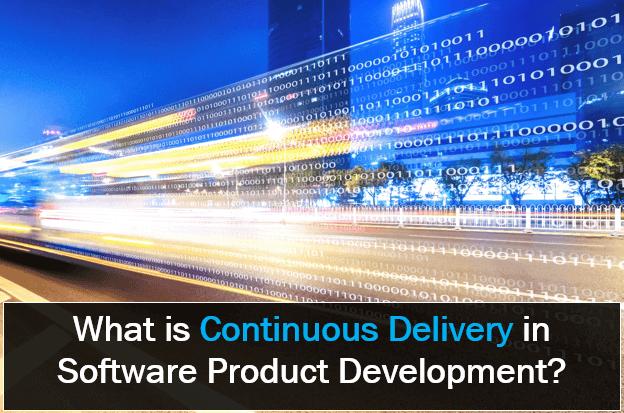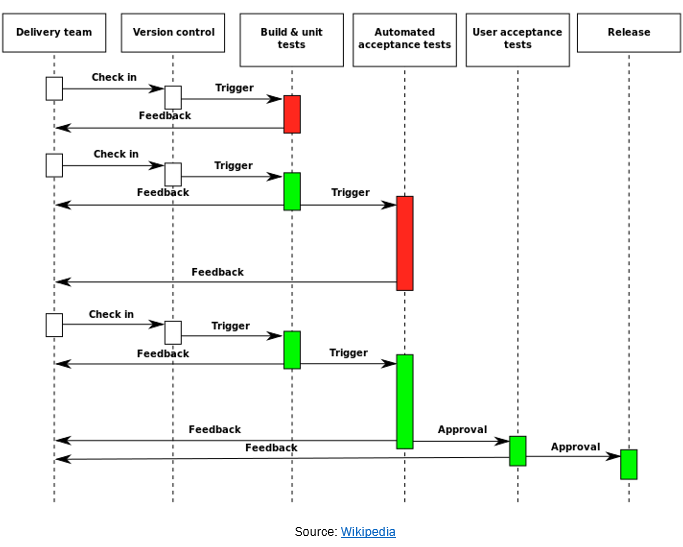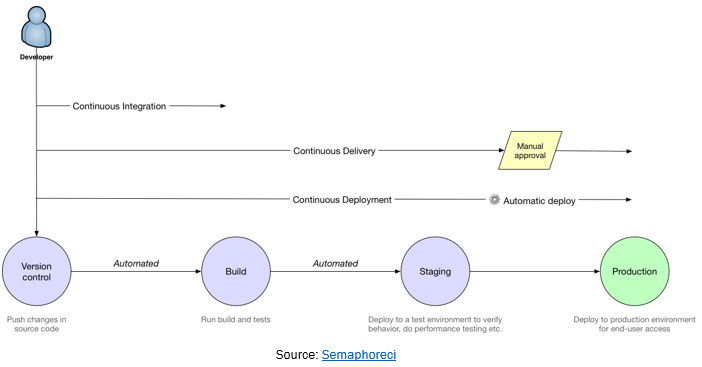The path to building exceptional software products is often obstructed by several hurdles; disjointed teams often end up affecting release cycles that not only result in a poor quality product, but also add to the overall cost of software development. With the software development landscape evolving so rapidly, traditional software product development and delivery methods are quickly becoming obsolete. If you are looking to improve your time-to-market, enhance your software quality, and set yourself apart from competition, DevOps can enable you to build high-quality software.

According to Puppet’s 2021 State of DevOps Report, 83 percent of IT decision-makers have reported that their organizations are currently integrating DevOps practices to achieve higher business value via better quality software, quicker delivery times, securer systems, and the codification of principles. Additionally, this same report has found that many who are in the middle stages of the DevOps process have plateaued. Continuous delivery, a subset of DevOps, produces software products in short cycles with reliable, manual releases.
Let’s look at what continuous delivery is, how it improves software product development speed, frequency, and reliability, and how it is different from continuous integration and continuous deployment.
Explore why software development companies should leverage both the waterfall and agile approaches to ensure a robust end-product, picking the advantages of both models with our eBook.
What is Continuous Delivery in Software Product Development?
Continuous delivery (CDE) is a software engineering approach which enables teams to produce software in short cycles and ensures that the software can be manually and reliably released at any time. It aims to automate the software delivery process by building, testing, and releasing new features and changes with greater speed, accuracy, and frequency.
Moreover, the approach helps reduce the cost, time, and risk of delivering changes by allowing for more incremental updates to applications in production. CDE is enabled through the deployment pipeline, and uses automatic or manual processes to ensure frequent releases of bug-free software into production. The deployment pipeline has three components:
- Visibility – All aspects of the delivery system including build, deploy, test, and release are visible to every member of the team to promote collaboration.
- Feedback – Team members learn of problems as soon as they occur so that they are able to fix them as quickly as possible.
- Continuous Deployment – Through a fully automated process, you can deploy and release any version of the software to any environment.

5 Benefits of Continuous Delivery (CDE)
In an industry characterized by long periods of software development, looming deadlines, big releases, and stressful remediation of bugs, CDE enables software releases to be small, predictable, less dramatic, and more interesting. When well executed, CDE enables organizations to respond quickly to market fluctuations and customer demands. Listed below are some benefits of CDE:
1. Accelerated Time to Market
The software delivery lifecycle can sometimes take weeks or even months to integrate, and many organizations simply don’t have that kind of time. As market conditions change constantly, CDE lets organizations deliver the business value inherent in new software releases to customers more quickly. By implementing new changes and features more frequently, CDE helps them to stay a step ahead of the competition.
2. Quick Feedback
Frequent releases let the application development teams obtain user feedback more quickly. Teams can work in collaboration to develop useful features. If they find that a feature isn’t useful, they simply flick it and move on to the next useful feature. This helps in building the right product and boosts the overall end-user experience.
3. Enhanced Developer Productivity and Efficiency
CDE distributes the responsibility of software delivery more widely. This shared responsibility and collaboration enhances developer productivity and efficiency and makes life easier for everyone. It also brings about significant time savings through automation. This way, teams can spend time on other high-level activities such as testing.
4. Reliable Releases
CDE allows developers to release small batches of working software quickly and easily to production. The risks associated significantly decrease, and the release process becomes more reliable. Since the deployment process and scripts are tested repeatedly, finding and fixing problems is easier, and reduces the impact they have on the overall product.
5. Improved Customer Satisfaction
Since CDE takes customer feedback very seriously, it ensures every need is taken care of. Also, as the number of open bugs and production incidents decrease significantly, a higher level of customer satisfaction is achieved.
How is Continuous Delivery Different from Continuous Integration and Continuous Deployment?
Continuous Delivery, Continuous Deployment and Continuous Integration are all part of a software product development and delivery mechanism called DevOps. Continuous Integration (CI) is the practice of integrating the working copies of every developer into a central repository several times a day. Since each check-in is verified by an automated build, teams can collaborate better, detect problems early, and ensure a better-quality product.
The main aim of CI is to make the process of integration as simple as possible and reduce overall build costs. Since developers regularly integrate their code into a common repository, software product development happens in collaboration and in spurts rather than in isolation and at the end of the cycle.

This way, developers can achieve earlier RI for each feature that is developed, and also receive user feedback quickly. In CD, teams rely on infrastructure that automates and instruments the various steps leading up to deployment. As each integration successfully meets the release criteria, the live application is updated with new code.
Comparison Chart: Continuous Integration, Continuous Delivery, and Continuous Deployment
Continuous Integration (CI) |
Continuous Delivery (CDE) |
Continuous Deployment (CD) |
|
Product Focus |
All three concepts focus on automating mundane processes related to development and deployment of software, allowing developers to release features and changes in small batches and on a regular basis. | ||
Development Features |
CI enables developers to integrate their working copies into a central location as often as possible. | CDE is an extension of CI that enables developers to release new changes to customers quickly and in a sustainable way. | CD goes one-step further, and ensures every change that passes all stages of the production pipeline is released to production. |
Deployment Features |
There is no deployment in CI. Developer changes are merged to a single repository and are validated using automated tests. | In CDE, the release process is automated, but deployment to production does not happen automatically; it requires human intervention. | In CD, deployment happens automatically; there is no human intervention needed. Only a failed test will restrict a new change to be deployed to production. |
Advantages & Disadvantages |
CI is useful for merging various versions and parts of an application at one single place. | Since deployment requires little manual intervention, CDE allows users to have control over when they want to deploy something to production. | CD is useful when software is required to be put into production as soon as any change is made in the code. The automated deployment feature helps to deploy the change to prod immediately. |
Continuous Delivery (CDE) for Continuous Success
As software product development teams around the world get crushed under the weight of constant change, the DevOps approach acts as a silver lining; over 84% of organizations are adopting some aspect of DevOps principles, and the market is expected to reach $12.85 billion by 2025. By enabling software development teams to release working software frequently, it helps in minimizing the occurrence and impact of bugs and ensures a good-quality product is delivered to the end customer.
CDE, an integral aspect of DevOps, aims to minimize the friction points that are inherent in software deployment or release processes. By automating each of the steps for build deployments, it ensures safe code release. When combined with CI and CD, it improves collaboration between various teams and enables the delivery of high-quality software for continued success.
Schedule a free consultation to speak to a Synoptek expert about continuous delivery and how it can be used to optimize the software development process. And for any additional questions, contact us today.



